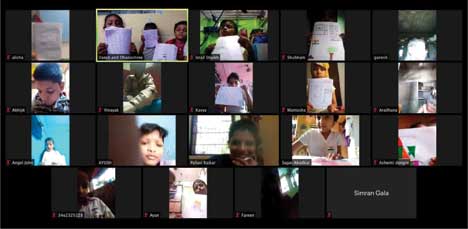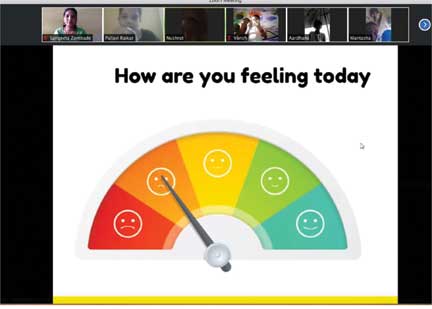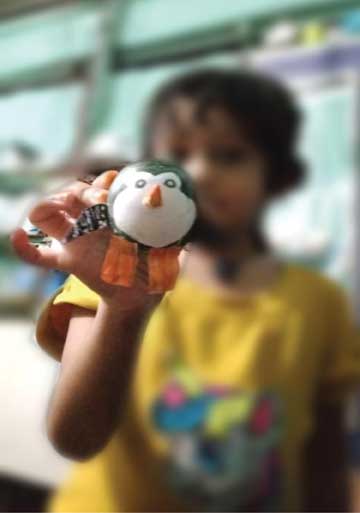Sangeeta Zombade & Pallavi Raikar
When a complete lockdown was announced on 24th March, 2020, our priorities as groups and individuals changed overnight. A week before that, some of us were hanging out with friends, some were planning the next vacation, some were thinking about finding a new job and some were catching up on movies. The very next week we began to think about surviving, managing food and money on a day-to-day basis and protecting ourselves from the danger outside. None of us was looking at hanging out with friends or catching up on the movies because it was no longer relevant, it no longer held meaning in life, at least for a while.
For a school like ours the mission, priorities, and learning methods took a 360° turn. The questions that bogged us down – How are children going to be ready for learning when their basic needs are not being adequately fulfilled? How are families going to get through this unplanned lockdown? How do we restructure our focus on the care for children and families that we work with? How do we stick to our philosophies of being a multicultural and community school while tackling these challenges?

Acknowledging the change
While our efforts as a school have always been to make education relevant to life, in unforeseen circumstances, the relevance involved shifting focus completely to the here and now, to responding to the challenges we were facing. A regular school planning day that was spent in arranging classrooms, ordering new material, was now spent on trying to arrange food and ration for the community and caregivers. Most of the children and families weren’t acquainted with virtual learning and to even envision having a Zoom class was a far-fetched idea. With baby steps, we started familiarizing caregivers with virtual learning. This was when community mapping, which was otherwise not used much, became an important tool to map families to group them in the same virtual learning places where a partnership with the caregivers became an important aspect and support system.
A day in the times of virtual classrooms
A typical classroom day that was spent in free play and settling in, knowing the teachers, making new friends was now moving towards – learning mute and unmute, keeping the video on/off, etc. This became part of the daily vocabulary. Check-in questions changed to understand and talk about how the pandemic has impacted us. “What did you do at home today?” “Who do you miss the most?”, “How are you taking care of yourself?” This led them to have conversations with each other. One such conversation was when a student asked his classmate, “How are you and where are you?” to which the other student replied, “I am at my window.” To this, the student who asked the question said, “Hey, stay home, don’t go outside, you know what is happening around, right?”
The caregivers of our students became our biggest support system. It was an eye-opener for us to see the learning-shaping that happens at home with available material. Since the closure of shops, we had to think about what could be done with limited and easily accessible material. We engaged the children in activities such as making homemade and natural colours, using dal or dough to make objects or even improve their vocabulary.
What changed for us as a team
The school team started coming together more often to talk about how we could structure care and make this experience of learning joyful for children because teaching and learning virtually was new not just for the students, but also for the teachers, and creating a support system for each other was equally important.
 We started planning objectives for each week depending on the experiences that children were sharing to make learning more relevant. Opportunities were created to relate their learning to their everyday lives. When we decided to hold a virtual celebration of Independence, we gathered some ideas about how to make the most of this limited celebration. We wanted to maintain the sanctity of the day but also wanted to celebrate it with children more meaningfully. We started the day with an interesting story called Sameer’s house which tries explaining to the audience the location of his house in a small gully in India. The story led to a discussion on where we all might be located currently and how big India is as a country. This was followed by a small discussion on exploring the answers to ‘Why do we stand up for the National Anthem?’ One of the teachers even invited children to think about a song that they relate most to Independence day and went on to play it for them.
We started planning objectives for each week depending on the experiences that children were sharing to make learning more relevant. Opportunities were created to relate their learning to their everyday lives. When we decided to hold a virtual celebration of Independence, we gathered some ideas about how to make the most of this limited celebration. We wanted to maintain the sanctity of the day but also wanted to celebrate it with children more meaningfully. We started the day with an interesting story called Sameer’s house which tries explaining to the audience the location of his house in a small gully in India. The story led to a discussion on where we all might be located currently and how big India is as a country. This was followed by a small discussion on exploring the answers to ‘Why do we stand up for the National Anthem?’ One of the teachers even invited children to think about a song that they relate most to Independence day and went on to play it for them.
Learning from the here and the now
Relating experiences was not limited to this celebration but also included academic subjects. A spoon that used to be a vocabulary picture on the school wall was now a handy real object which had multiple sizes and usages. Creativity took a new shape and form, expanding relevant connections to the material and going deeper into learning more about it.
One example was when we started doing a Marathi poem which mentioned a wall clock many times. The students were delighted and shared how the wall clock in their house looked. Inspired by this we did another poem in Hindi about rasoighar (kitchen) where the kitchen tools converse with each other about their work. Once the students understood the gist of the poem, the teacher asked the students to look at their own kitchen and find out what tools they have. The students were excited to bring in their own kitchen tools and show them to their classmates. This led to wonderful conversations around how we roll a chapati with a rolling pin? What is the best way to make tea and coffee? How to make tasty Maggi? These responses came from the students who had begun to help their caregivers in household chores.
We also got a chance to briefly challenge some gender roles. When asked who works in the kitchen, most students replied that it was their mother or sister but one of the students said, “It is not necessary that only a mother works in the kitchen, fathers can also work in the kitchen.”
As a school, we maintain portfolios for each child to encourage children to keep a record of the work they do. It also helps children to evaluate their own learning and see their progress along with their caregivers. With the schools shut, the portfolios were no longer accessible, but it was important for children to file their project work so that they could understand their learning journey. A teacher then designed an art activity using newspapers to make folders and caregivers’ partnered with students to maintain them.
Academics and its relevance to life
As educators we became more aware that academics also needed to be relevant. In a classroom, sometimes language, math or science are merely subjects or concepts but the reality is they are everywhere. Since we were confined to our homes, we decided to explore these possibilities. Here are some ways in which links between academics and everyday life can be established in small ways:
- Assignments can be given on counting the number of vegetables that goes into making food daily, noting the colour and smell of different spices.
- Weather can be observed on a weekly basis. Children can note the number of times the sky changes colour.
- Children can find a few things with a certain letter in their house and describe its colour, shape, usage.
- Invite children to imagine what would happen if their kitchen utensils start talking to each other.
- Invite children to form groups and create a math game using items from their home.
 So far so good
So far so good
These are some activities that we discovered in our journey of teaching and learning during the pandemic. While this has been insightful and exciting, it also had challenges. It is easier for teachers to be a part of the everyday lives of the children when they meet them in person, visit their homes, talk to their caregivers, etc. With children who moved back to their villages during the lockdown, it became difficult for us to fully understand their experience and challenges. It took us some time to prepare ourselves and then to prepare the children for something we both had limited knowledge of.
Learning is a lifelong journey!
The bigger question that confronted us was, ‘What was really relevant now?’ Our students’ responses helped us understand the answer. We were able to notice that children have the ability to take agency and accountability for their learning and it is necessary for educators to ask the right questions at the right time.
The pandemic has had an impact on the social and emotional well being of children and adults alike. The first step to making the learning relevant for children is creating a safe space for them. A place so safe that when the learning is not relevant, the children feel free to point that out and change the direction of their learning.
For some educators, this was an opportunity to have a breathing space to decide what was important in terms of learning. For others, it was a risk to change the learning methodology. It is important that we let these emotions visit us and let the discomfort stay. We are on a journey where we will make several mistakes before figuring out what makes sense. Our experience says that life when brought into spaces of learning, itself makes learning relevant. What are some of your experiences?
Inputs by Priyanka Srivastav & Vanisha Shetty
The authors can be reached at sangeeta.zombade@khojschool.org, pallavi@apnishala.org.
Related articles
